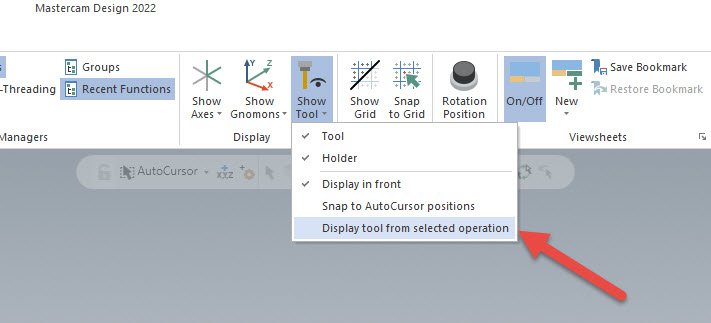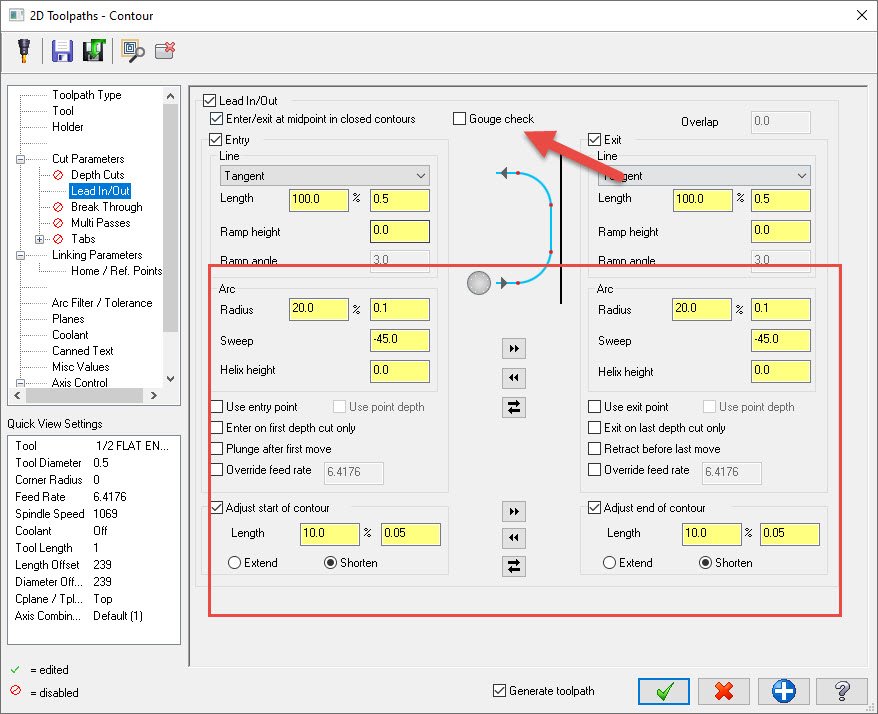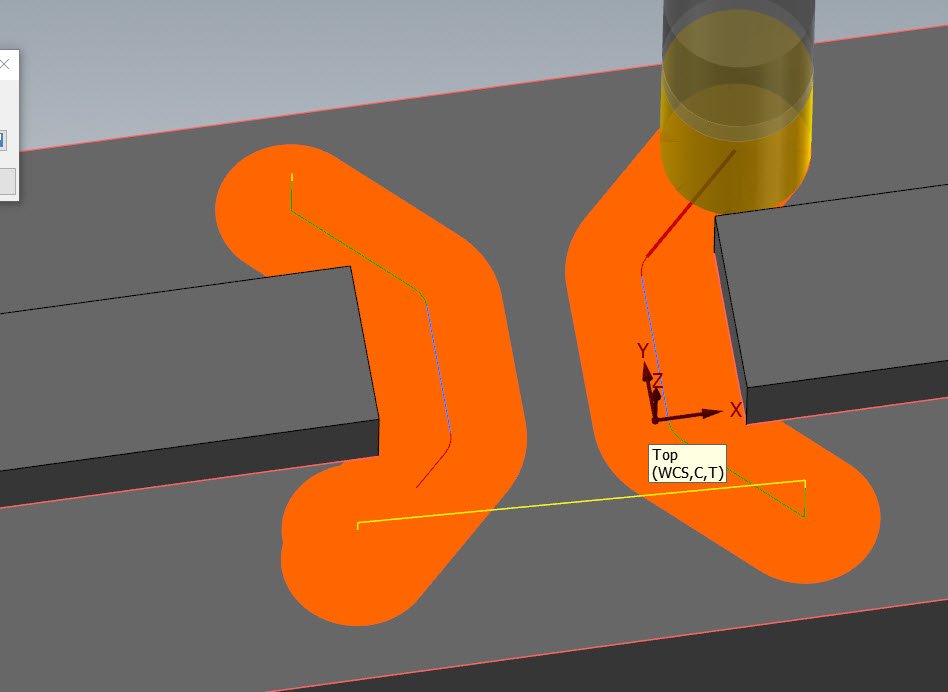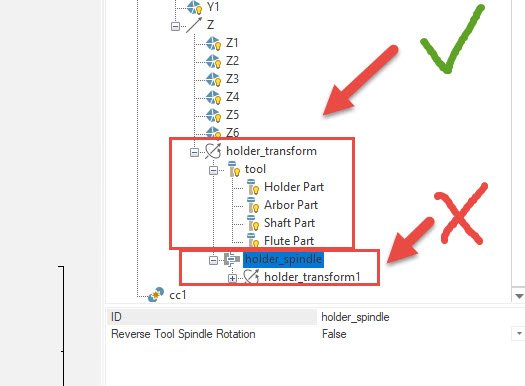-
Posts
499 -
Joined
-
Last visited
-
Days Won
32
Content Type
Profiles
Forums
Downloads
Store
eMastercam Wiki
Blogs
Gallery
Events
Everything posted by Chally72
-
Had to chuckle at the shaded stock preview. Is it a graphical issue only or is it actually swapping the stock shape type in the background? This would be a good one to send in if the file saves in this state/is repeatable.
-
It definitely gets complex quickly if you have Stock to Leave values other than zero on your floor surfaces, too. If you're having to use specific increments/math on the stepups, the Adjust for Stock to Leave checkbox above the min/max depth field is there to automatically shift those min/max values by the Geometry stock to leave amount. It decouples having to make a stepup increment value change to get back to the same cut result if you end up going and changing the Floor Stock value by some amount.
-
Putting a Stepup value in that matches the Stepdown value will basically tell Optirough to machine all flats that occur within the Stepdown window. Stepup values that do not match the Stepups will net you terrace steps that may or may not actually clear away material on ledges and such to the exact amount of Stock On requested in the geometry page.
-
You can always define the slitting saw as a normal Slot tool, (with no nut) and then use the Import Geometry from File button on the Define Tool Geometry page and draw in a model of the tool that includes the nut on the bottom. The toolpath is calculated off of the yellow parametric tool definition of the slotting tool, but the Green imported geometry will be shown in Verify/Simulation so you can check the nut clearance. There's nothing any toolpath would be able to do to calculate clearance against the nut anyway during path generation, so this gives you the best of both worlds.
-
Hey guys, When Mastercam installs, it extracts files to a user temp directory for use in the installation. (To be clear, not just the downloads folder. These are windows hidden folders such as User\appdata\Local\temp\) When installing an update patch, it goes and looks for those files in that directory. If the user account you're installing Update 1 under is a different one than the base installation was done under, and doesn't have permissions to access that temp file directory, Update 1 will be unable to get at the files it needs. Similarly, if the temp directory was wiped or files removed at some point after the original installation, or if there are permissions conflicts either during original installation or during Update installation, the Update install will likely be unable to continue and the Repair installation option will also likely not help. The quickest way out in these scenarios, if you can't do the install under the same user account as the original or the files are gone, would be to uninstall and reinstall the base Mastercam version, and then go and run the Update 1 patch now that the necessary files exist and you know you have the correct permissions. Hope this helps.
-
If you haven't already done so, try setting your NVIDIA settings for Mastercam to always use the dedicated graphics card. See my post in the thread below for a little guide to do so- substitute 2022 for 2018:
-
Everyone prepare for the transition from "Here's the 43 steps to making this point-perfect multiaxis path" posts to "How the heck do I cut this waspalloy material?!"
-

Mcam 22 Machine Configuration settings...what am I missing?
Chally72 replied to Dontech's topic in Industrial Forum
In 2020 we started adding checks to make sure your machine definition build was a valid one. Before that, it was a bit of a wild west and you could build and set combinations that weren't technically complete or possible. Since more and more elements in things like posts are relying on Machine Definition data being correct, it was important to start flagging MD's that were set up incorrectly. To confirm, this likely isn't a migration issue and going directly from 18 to 22 should not affect the outcome here. As thoughts right off the bat based on your picture, I see no table/spindle Components listed in your Axis Combination. to the right of the Axes. -
See that toggle choice right above the red arrow in my picture above- that should do it!
-
-

Getting lens form cutter to work in a pocket, not succeeding
Chally72 replied to Hydrazine's topic in Industrial Forum
All 3D HST paths support circle segment/Accelerated Finishing geometry, though of course you won't have much control over the contact point. For multiaxis, a Parallel cut pattern strategy, with a curve selection of the pocket outer extents, and passes set to spiral, should get you a good initial pattern that only leaves the outer pocket fillet/wall to deal with. To get a lens tool to blend out into a perimeter radius in a pocket, I like to use a Tilt Tool collision control strategy to finish up. See how it affects the final passes on the part in the video below to get the lens tool all the way in the corner fillet even when my side tilt strategy for the rest of the path is calling for a different contact point. As long as your tilt strategy puts the tool reasonably close to the right position, this will tilt into the corner fillets very nicely and you'll be hard pressed to see the transition point. A file would be the best way forward if you're still having trouble. Hope this helps! -
Hey guys, thread here on the official forum with a workaround to get your colors back: https://forum.mastercam.com/ShwMessage.aspx?TopicID=43441&Update=1 And summary:
-
You should send this one in- that sounds like a graphical issue to me.
-
The standalone manager feature set and the capabilities available in Mastercam have slowly diverged over the years as a consequence of new features/functionality in Mastercam, interface limitations on the standalone manager side, etc. The natural consequences of this are there are growing lists things you can only do in one or the other, which is obviously not ideal. Eventually the tool team would like to ease some of these issues. Perhaps Rich will chime in on this thread.
-
For filming and environmental reasons, we don't actually run coolant in our Manufacturing Lab machines at Mastercam. It makes the stainless work a little more challenging!
-
I made a little video to talk about creating, linking, and associating planes. There's a much better video coming on our official channel later this year, but this gives you all the important info about the cool stuff you can do with plane linking in 2022:
-
You can easily edit a plane at any time and unlink it. You can furthermore have a parent plane that is associative to a piece of geometry, and then child planes that are all linked to that parent plane with different relative offsets, and if down the line you do something like Move or push/pull that associative geometry, all planes will correctly move to follow.
-
QC/Tech Support would probably like to look at that one too, if you can share.
-

Post Machine Definition Spindle cannot be set as 3D vector
Chally72 replied to Doug Schaefer's topic in Industrial Forum
Please send this in to [email protected] with a part file and detailed description of the problem so we can take a look. Referencing this thread would help as well. -
This is a perfect opportunity to take advantage of the new parent/child plane relationships that you can build in Mastercam 2022. Even if not associated to geometry, planes can be linked to each other such that when the parent plane is moved (translated/rotated) the child planes will all move with it.
-
You can do this with a change to leadin/leadout while retaining just those edges as a selection. Just make the arc a negative number instead of a positive, and shorten up the contour length by a similar length as whatever radius you're targeting. See below for an extreme example- you can play around with parameters to get whatever break edge or roll you really want out of it. Make sure to turn off Gouge Check so that it doesn't automatically trim out what you're trying to do.
-

Post Machine Definition Spindle cannot be set as 3D vector
Chally72 replied to Doug Schaefer's topic in Industrial Forum
It sounds like you've got some issues with your custom machine definition. Machine Simulation is trying to get around them each time by applying a default definition when you launch into Verify or Sim, but it doesn't fix the issues with your machine file. Right off the bat, I'd ask how you defined your tool/holder components in the machine. If you added the holder Spindle group component instead of the single holder transform group, this along with incorrect definition of direction/etc might lead to your error message: -

HS Waterline surface finish tool path gauging in mc 2022 ?
Chally72 replied to mig's topic in Industrial Forum
It cannot do this because this would be two branching paths of simulation. It also cannot ever truly match what your machine dogleg will look like, as that's based on individual axis acceleration curves- so even if Verify shows your dogleg clearing by 0.03", and thus doesn't trigger a warning, a slight change in actual machine acceleration could mean that your 0.03" of clearance now becomes -0.1" of clearance and you just clipped the part. Dogleg crashes shown in verify are at best, a guess at machine behavior defined by a fixed acceleration number in the machine def. Best practice is really to never be introducing G0's in your toolpath while your tool is doing a "death star run" down in the valley between part features. -

HS Waterline surface finish tool path gauging in mc 2022 ?
Chally72 replied to mig's topic in Industrial Forum
Here's a video that focuses just on the new Linking page and explains how to build leads. That new page is a lot to take in and it isn't immediately apparent how primary and secondary leads stack/interact with each other. -
Dynamic motion produced through Optirough is a different calculation method and is superior to that of the trochoidal motion produced through Triangular mesh and even Pocketing. If doing a tool life comparison on a harder material, Optirough would come out on top. I'm partial to the more sensical motion in each slice in terms of backfeeds/retracts/etc, in Optirough as well. You also have all the other advantages that come along with the 3D toolpaths such as the ability to have multiple part and avoidance groups with variable stock to leave. Unless you absolutely need 5 axis motion for a certain feature, 3+2 roughing with Optirough is the best choice for both toolpath results and machine rigidity/tool life.
- 1 reply
-
- 6
-

Join us!
eMastercam - your online source for all things Mastercam.
Together, we are the strongest Mastercam community on the web with over 56,000 members, and our online store offers a wide selection of training materials for all applications and skill levels.











